New Mars Forums
You are not logged in.
- Topics: Active | Unanswered
Announcement
#251 2007-12-07 07:03:41
- cIclops
- Member
- Registered: 2005-06-16
- Posts: 3,230
Re: Cassini-Huygens - NASA/ESA Saturn orbiter & Titan lander

Titan Makes Contact - imaged 1 Aug 2007
More details and full resolution image
The murky orange disk of Saturn's moon Titan glides past -- a silent, floating sphere transiting Saturn.
Titan's photochemical smog completely obscures the surface in such natural color views. Its high-altitude hazes are visible against the disk of Saturn as they attenuate the light reflected by the planet.
Titan is 5,150 kilometers (3200 miles) across. The view was acquired from less than a degree above Saturn's ringplane.
Images taken using red, green and blue spectral filters were combined to create this natural color view. The images were obtained with the Cassini spacecraft narrow-angle camera on Aug. 1, 2007, at a distance of approximately 2.4 million kilometers (1.5 million miles) from Titan. Image scale is 15 kilometers (9 miles) per pixel.
[color=darkred]Let's go to Mars and far beyond - triple NASA's budget ![/color] [url=irc://freenode#space] #space channel !! [/url] [url=http://www.youtube.com/user/c1cl0ps] - videos !!![/url]
Offline
Like button can go here
#252 2007-12-29 03:15:03
- cIclops
- Member
- Registered: 2005-06-16
- Posts: 3,230
Re: Cassini-Huygens - NASA/ESA Saturn orbiter & Titan lander
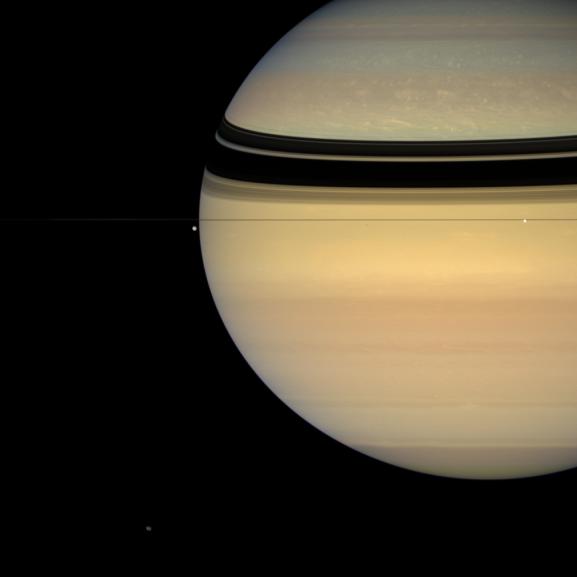
This colorful view, taken from edge-on with the ringplane, contains four of Saturn's attendant moons. Tethys (1,071 kilometers, 665 miles across) is seen against the black sky to the left of the gas giant's limb. Brilliant Enceladus (505 kilometers, 314 miles across) sits against the planet near right. Irregular Hyperion (280 kilometers, 174 miles across) is at the bottom of the image, near left. Much smaller Epimetheus (116 kilometers, 72 miles across) is a speck below the rings directly between Tethys and Enceladus. Epimetheus casts an equally tiny shadow onto the blue northern hemisphere, just above the thin shadow of the F ring.
Images taken using red, green and blue spectral filters were combined to create this natural color view. The images were acquired with the Cassini spacecraft wide-angle camera on July 24, 2007 at a distance of approximately 2 million kilometers (1.2 million miles) from Saturn. Image scale is 116 kilometers (72 miles) per pixel on Saturn
[color=darkred]Let's go to Mars and far beyond - triple NASA's budget ![/color] [url=irc://freenode#space] #space channel !! [/url] [url=http://www.youtube.com/user/c1cl0ps] - videos !!![/url]
Offline
Like button can go here
#253 2008-01-09 08:49:19
- Palomar
- Member
- From: USA
- Registered: 2002-05-30
- Posts: 9,734
Re: Cassini-Huygens - NASA/ESA Saturn orbiter & Titan lander
Those are terrific photos, cIclops. ![]()
Some recent headlines pertaining to Saturn/Cassini:
Puzzing hot spots:
http://www.space.com/scienceastronomy/0801...turn-spots.html
Both of Saturn's poles have surprising swirling hotspots that persist even through years of polar winter, a new study reveals.
The hotspots are localized areas in Saturn's gaseous atmosphere over its poles that are considerably warmer than the surrounding air — they're actually about as warm as the atmosphere at Saturn's equator
Whoa! :shock:
Scientists had thought that solar irradiation might be generating the hotspot in the southern hemisphere (currently in its summer phase, facing the sun), but the existence of a similar hotspot in the northern hemisphere, which has been plunged in wintry darkness for many years, suggests that isn't the case.
Yeah, that seems logical (isn't the case).
Instead, dynamic processes in Saturn's atmosphere may create the hotspots, the new findings, detailed in the Jan. 4 issue of the journal Science, suggest, Fletcher says.
Air being sucked downward at the poles may cause the hotspots, while air moving upward in the atmosphere may be creating a cold "collar" around the hotspots. These air movements could be responsible for the raging hurricane-like storm imaged over the south pole in 2006.
And they mention The Hexagon at the north pole:
As unusual as the hotspots themselves is the warm hexagonal ring of air surrounding the cold collar of the northern hemisphere hotspot. Stranger still is the lack of such a shape around the south pole.
"The mystery is... why on earth — or why on Saturn even — do we see a hexagon around the north pole, and not around the south pole?" Fletcher told SPACE.com.
I've also wondered that. Like many folks following this, I'm sure.
Other missions have provided hints that Jupiter and Neptune have hotspots over their poles as well, suggesting they could be a feature of the atmospheres of all gaseous planets
And wouldn't it be mind-blowing if all other gas giants also have northern pole hexagons? Although I'd think Galileo would have spotted that during its Jupiter mission; I'd be surprised if they didn't fly Galileo directly over/under each pole (but I can't recall; it's been a while now).
-*-
Recycling "old timers"
http://www.saturndaily.com/reports/Saturn_...Timers_999.html
New observations by NASA's Cassini spacecraft indicate the rings of Saturn, once thought to have formed during the age of the dinosaurs, instead may have been created roughly 4.5 billion years ago, when the solar system was still under construction.
led scientists (previously) to believe Saturn's rings were relatively youthful and likely created by a comet that shattered a large moon, perhaps 100 million years ago. But ring features seen by instruments on Cassini -- which arrived at Saturn in 2004 -- indicate the rings were not formed by a single cataclysmic event. The ages of the different rings appear to vary significantly, and the ring material is continually being recycled
"The evidence is consistent with the picture that Saturn has had rings all through its history,"..."We have discovered that the rings probably were not created just yesterday in cosmic time, and in this scenario, it is not just luck that we are seeing planetary rings now," said Esposito. "They probably were always around but continually changing, and they will be around for many billions of years."
8)
Scientists had previously believed rings as old as Saturn itself should be darker due to ongoing pollution by the "infall" of meteoric dust, leaving telltale spectral signatures, Esposito said. But the new Cassini observations indicate the churning mass of ice and rock within Saturn's gigantic ring system is likely much larger than previously estimated. This helps explain why the rings overall appear relatively bright to ground-based telescopes and spacecraft.
Wow. ![]()
clumps of icy boulders that are continually collecting and disbanding due to the competing processes of shattering and coming together again. The team tagged the clumpy moonlets with cat names like "Mittens" and "Fluffy" because they appear to come and go unexpectedly over time and have multiple lives, said Esposito.
Lol...cute.
Esposito stressed that Saturn's rings of the future won't be the same rings we see today, likening them to great cities around the world like San Francisco, Berlin or Beijing. "While the cities themselves will go on for centuries or millennia, the faces of people on the streets will always be changing due to continual birth and aging of new citizens."
An addition to that article:
http://www.space.com/imageoftheday/imag … 80107.html
Bright Clumpy Moonlets and Cold Saturn Mittens
...so aptly named 'cause they remind us of kittens! ![]()
(Someone had the song "My Favorite Things" in mind apparently, lol)
Artist's conception.
We all know [i]those[/i] Venusians: Doing their hair in shock waves, smoking electrical coronas, wearing Van Allen belts and resting their tiny elbows on a Geiger counter...
--John Sladek (The New Apocrypha)
Offline
Like button can go here
#254 2008-01-10 04:19:45
- cIclops
- Member
- Registered: 2005-06-16
- Posts: 3,230
Re: Cassini-Huygens - NASA/ESA Saturn orbiter & Titan lander
Those are terrific photos, cIclops.
Thanks!
More fantastic images here from the Cassini favorite image contest, including this one

[color=darkred]Let's go to Mars and far beyond - triple NASA's budget ![/color] [url=irc://freenode#space] #space channel !! [/url] [url=http://www.youtube.com/user/c1cl0ps] - videos !!![/url]
Offline
Like button can go here
#255 2008-01-10 07:37:18
- Palomar
- Member
- From: USA
- Registered: 2002-05-30
- Posts: 9,734
Re: Cassini-Huygens - NASA/ESA Saturn orbiter & Titan lander
Thanks -- I'll check it out. ![]()
We all know [i]those[/i] Venusians: Doing their hair in shock waves, smoking electrical coronas, wearing Van Allen belts and resting their tiny elbows on a Geiger counter...
--John Sladek (The New Apocrypha)
Offline
Like button can go here
#256 2008-02-17 12:07:44
- cIclops
- Member
- Registered: 2005-06-16
- Posts: 3,230
Re: Cassini-Huygens - NASA/ESA Saturn orbiter & Titan lander

Jet Blue Enceladus - 10 Oct 2007
Cassini imaging scientists used views like this one to help them identify the source locations for individual jets spurting ice particles, water vapor and trace organic compounds from the surface of Saturn's moon Enceladus.
Their study -- published in the Oct. 11, 2007, issue of the journal Nature -- identifies eight source locations, all on the prominent tiger stripe fractures, or sulci, in the moon's south polar region. Some of the sources occur in regions not yet observed by Cassini's composite infrared spectrometer, and the researchers predict that future Cassini observations of those locations will find elevated temperatures.
This false-color view was created by combining three clear filter images taken at nearly the same time as Fountains of Enceladus - Image 2. This image product was then specially processed to enhance the individual jets that compose the plume. (Fountains of Enceladus - Image 2 was instead processed to reveal subtleties in the brightness of the overall plume that comprises the jets.) Some artifacts due to the processing are present in the image. The final product was colored as blue for dramatic effect.
[color=darkred]Let's go to Mars and far beyond - triple NASA's budget ![/color] [url=irc://freenode#space] #space channel !! [/url] [url=http://www.youtube.com/user/c1cl0ps] - videos !!![/url]
Offline
Like button can go here
#257 2008-02-17 12:16:25
- cIclops
- Member
- Registered: 2005-06-16
- Posts: 3,230
Re: Cassini-Huygens - NASA/ESA Saturn orbiter & Titan lander
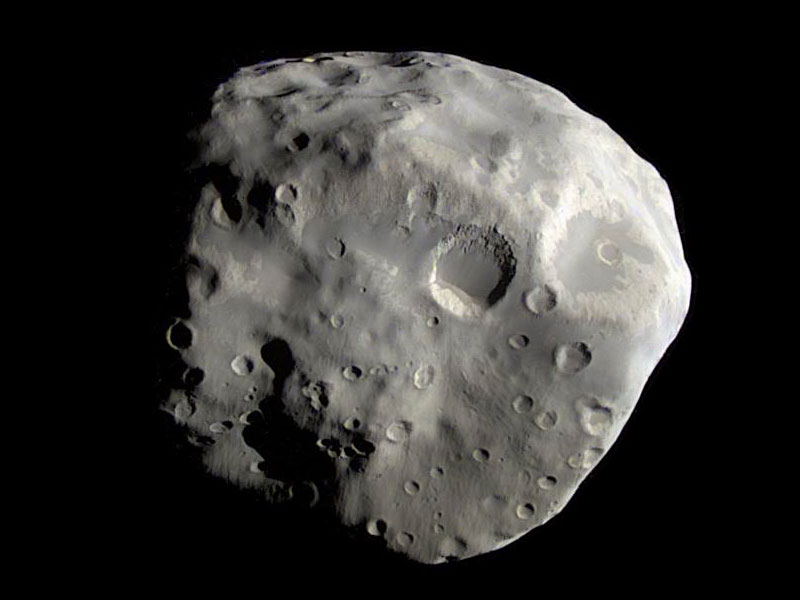
Epimetheus Revealed - imaged 3 Dec 2007
Higher resolution images & details
The Cassini spacecraft's close flyby of Epimetheus in December 2007 returned detailed images of the moon's south polar region.
The view shows what might be the remains of a large impact crater covering most of this face, and which could be responsible for the somewhat flattened shape of the southern part of Epimetheus (116 kilometers, or 72 miles across) seen previously at much lower resolution.
The image also shows two terrain types: darker, smoother areas, and brighter, slightly more yellowish, fractured terrain. One interpretation of this image is that the darker material evidently moves down slopes, and probably has a lower ice content than the brighter material, which appears more like "bedrock." Nonetheless, materials in both terrains are likely to be rich in water ice.
The images that were used to create this enhanced color view were taken with the Cassini spacecraft narrow-angle camera on Dec. 3, 2007. The views were obtained at a distance of approximately 37,400 kilometers (23,000 miles) from Epimetheus and at a Sun-Epimetheus-spacecraft, or phase, angle of 65 degrees. Image scale is 224 meters (735 feet) per pixel.
[color=darkred]Let's go to Mars and far beyond - triple NASA's budget ![/color] [url=irc://freenode#space] #space channel !! [/url] [url=http://www.youtube.com/user/c1cl0ps] - videos !!![/url]
Offline
Like button can go here
#258 2008-02-27 13:51:08
- DonaldSpace
- InActive
- From: AMERICA
- Registered: 2008-02-27
- Posts: 8
Re: Cassini-Huygens - NASA/ESA Saturn orbiter & Titan lander
the info and photos in this thread are spectacular
Offline
Like button can go here
#259 2008-02-27 14:49:34
- cIclops
- Member
- Registered: 2005-06-16
- Posts: 3,230
Re: Cassini-Huygens - NASA/ESA Saturn orbiter & Titan lander
Even more spectacular images should result from Cassini's next flyby of Enceladus. They plan to skim the moon at an altitude of 50 kms!
[color=darkred]Let's go to Mars and far beyond - triple NASA's budget ![/color] [url=irc://freenode#space] #space channel !! [/url] [url=http://www.youtube.com/user/c1cl0ps] - videos !!![/url]
Offline
Like button can go here
#260 2008-03-26 11:52:49
- Palomar
- Member
- From: USA
- Registered: 2002-05-30
- Posts: 9,734
Re: Cassini-Huygens - NASA/ESA Saturn orbiter & Titan lander
The latest on Titan:
With each flyby, NASA's Cassini spacecraft has been building up the case that there are lakes and seas of liquid hydrocarbons on the surface of Saturn's moon Titan. But now we get the stunning news that the planet might have vast oceans of water and ammonia underneath its surface as well.
"We believe that about 62 miles beneath the ice and organic-rich surface is an internal ocean of liquid water mixed with ammonia..."
Since Titan has an incredibly thick atmosphere, 1.5 times more dense than the Earth, it's possible that powerful winds are rocking the moon back and forth around its axis. It might be speeding the rotation up at one point in the year, and then slowing it back down again. But this would only be possible if there's an ocean underneath the surface that the entire crust floats on top of.
http://www.universetoday.com/2008/03/20/un...vered-on-titan/
We all know [i]those[/i] Venusians: Doing their hair in shock waves, smoking electrical coronas, wearing Van Allen belts and resting their tiny elbows on a Geiger counter...
--John Sladek (The New Apocrypha)
Offline
Like button can go here
#261 2008-03-26 12:38:23
- cIclops
- Member
- Registered: 2005-06-16
- Posts: 3,230
Re: Cassini-Huygens - NASA/ESA Saturn orbiter & Titan lander

Enceladus - with heat radiating from the entire length of 150 kilometer long fractures
NASA TV just webcast a science briefing about Enceladus saying that organics, plenty of heat and the possibility of liquid water give it a high astrobiological potential
Cassini Tastes Organic Material at Saturn's Geyser Moon - 26 Mar 2008
NASA's Cassini spacecraft tasted and sampled a surprising organic brew erupting in geyser-like fashion from Saturn's moon Enceladus during a close flyby on March 12. Scientists are amazed that this tiny moon is so active, "hot" and brimming with water vapor and organic chemicals.
New heat maps of the surface show higher temperatures than previously known in the south polar region, with hot tracks running the length of giant fissures. Additionally, scientists say the organics "taste and smell" like some of those found in a comet. The jets themselves harmlessly peppered Cassini, exerting measurable torque on the spacecraft, and providing an indirect measure of the plume density.
"A completely unexpected surprise is that the chemistry of Enceladus, what's coming out from inside, resembles that of a comet," said Hunter Waite, principal investigator for the Cassini Ion and Neutral Mass Spectrometer at the Southwest Research Institute in San Antonio. "To have primordial material coming out from inside a Saturn moon raises many questions on the formation of the Saturn system."
[color=darkred]Let's go to Mars and far beyond - triple NASA's budget ![/color] [url=irc://freenode#space] #space channel !! [/url] [url=http://www.youtube.com/user/c1cl0ps] - videos !!![/url]
Offline
Like button can go here
#262 2008-03-26 14:59:02
- RedStreak
- Banned
- From: Illinois
- Registered: 2006-05-12
- Posts: 541
Re: Cassini-Huygens - NASA/ESA Saturn orbiter & Titan lander
A Titan-Enceleadus explorer would no doubt gain some merit for funding after this finding!
Offline
Like button can go here
#263 2008-03-27 00:35:46
- cIclops
- Member
- Registered: 2005-06-16
- Posts: 3,230
Re: Cassini-Huygens - NASA/ESA Saturn orbiter & Titan lander
A Titan-Enceleadus explorer would no doubt gain some merit for funding after this finding!
Yes. An ion drive spacecraft with a lander and an organics analyzer perhaps.
Enceladus results science briefing - video 18:36 mins - 26 Mar 2008
[color=darkred]Let's go to Mars and far beyond - triple NASA's budget ![/color] [url=irc://freenode#space] #space channel !! [/url] [url=http://www.youtube.com/user/c1cl0ps] - videos !!![/url]
Offline
Like button can go here
#264 2008-03-27 09:19:25
- Palomar
- Member
- From: USA
- Registered: 2002-05-30
- Posts: 9,734
Re: Cassini-Huygens - NASA/ESA Saturn orbiter & Titan lander
More on Enceladus:
http://news.yahoo.com/s/ap/20080327/ap_ … aturn_moon
found organic matter
The discovery excited mission team members, who say it's a marker for further research into whether the icy satellite Enceladus has such an environment.
The chemical analysis by Cassini revealed that Enceladus' interior was similar to that of a comet.
A friend (elsewhere) had proposed that perhaps a comet smacked into Enceladus ages ago.
While the jet plumes were mostly water vapor, the probe found traces of methane and simple organic compounds
"We clearly have the organics and are closing in on the question of liquid water in the interior"
Detailed heat maps of the lunar surface revealed the south pole is warmer than previously thought. Temperature measurements show the region is at least minus 135 degrees Fahrenheit — 63 degrees hotter than previously known.
We all know [i]those[/i] Venusians: Doing their hair in shock waves, smoking electrical coronas, wearing Van Allen belts and resting their tiny elbows on a Geiger counter...
--John Sladek (The New Apocrypha)
Offline
Like button can go here
#265 2008-03-27 09:27:59
- Commodore
- Member
- From: Upstate NY, USA
- Registered: 2004-07-25
- Posts: 1,021
Re: Cassini-Huygens - NASA/ESA Saturn orbiter & Titan lander
If this was radioactive material, what would cause it to be distributed in this sort of... pattern?
"Yes, I was going to give this astronaut selection my best shot, I was determined when the NASA proctologist looked up my ass, he would see pipes so dazzling he would ask the nurse to get his sunglasses."
---Shuttle Astronaut Mike Mullane
Offline
Like button can go here
#266 2008-03-28 02:39:24
- cIclops
- Member
- Registered: 2005-06-16
- Posts: 3,230
Re: Cassini-Huygens - NASA/ESA Saturn orbiter & Titan lander
Warming of the surface from below causes expansion that results in fractures. This warming may be caused by tidal stresses and or radioactive heating. The surface heat pattern shows the energy radiating into cold space through these fractures.
[color=darkred]Let's go to Mars and far beyond - triple NASA's budget ![/color] [url=irc://freenode#space] #space channel !! [/url] [url=http://www.youtube.com/user/c1cl0ps] - videos !!![/url]
Offline
Like button can go here
#267 2008-04-15 22:11:06
- SpaceNut
- Administrator
- From: New Hampshire
- Registered: 2004-07-22
- Posts: 29,636
Re: Cassini-Huygens - NASA/ESA Saturn orbiter & Titan lander
Launched in October 1997, the nuclear-powered Cassini spacecraft spent seven years journeying to Saturn and has orbited the ringed planet since June 2004. The mission's end was originally set for July 2008.
With a tight budget for speeding up the path to orbit for Ares there is still money to be found???
Although operated by NASA, the European Space Agency and the Italian Space Agency, NASA rounded up the $160 million to fund the extension that will nearly double Cassini's orbits around Saturn as well as moon flybys.
The space agencies have spent a collective $3.27 billion designing, launching and operating the spacecraft, which sent the Huygens probe to Saturn's moon Titan in early 2004. NASA contributed the lion's share of the Cassini-Huygens program's cost, with $2.6 billion
Offline
Like button can go here
#268 2008-04-16 04:05:45
- cIclops
- Member
- Registered: 2005-06-16
- Posts: 3,230
Re: Cassini-Huygens - NASA/ESA Saturn orbiter & Titan lander
Good news. This mission is worth every cent, it's almost fully functional and sending back enormous amounts of data. There won't be another Saturn mission for ten years. Keep it going! (BTW ESA pay a good chunk of the cost)
Cassini Extended Missions (PDF 2MB) - lots of details here
[color=darkred]Let's go to Mars and far beyond - triple NASA's budget ![/color] [url=irc://freenode#space] #space channel !! [/url] [url=http://www.youtube.com/user/c1cl0ps] - videos !!![/url]
Offline
Like button can go here
#269 2008-04-16 16:33:30
- 3488
- Member
- From: Ashford, Kent, United Kingdom
- Registered: 2008-04-15
- Posts: 23
Re: Cassini-Huygens - NASA/ESA Saturn orbiter & Titan lander
You are not wrong there cIclops.
Cassini is worth every cent & more.
It is tremendous news that Cassini has been extended a minimum of two years.
This is fantastic news. We get to see the Saturn Equinox in December 2009 (Titan's August 2009).
Great news, I had heard of some of what's planned & hope at least some of those 26 passes of Titan are Sythetic Aperture Radar imaging passes. 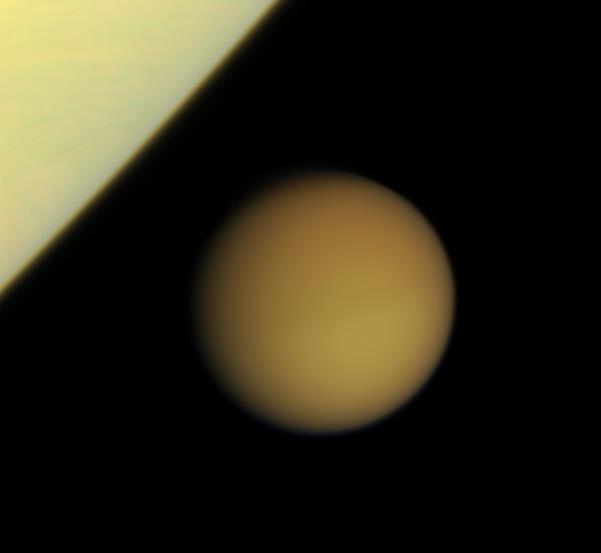
The seven passes of Enceladus will be interesting, as the Tiger Stripes move into the night. We'll see if the activity continues after the Sun sets. If it does not, it will prove that the geysers are solar powered, if it does, than definately internally driven or tidal.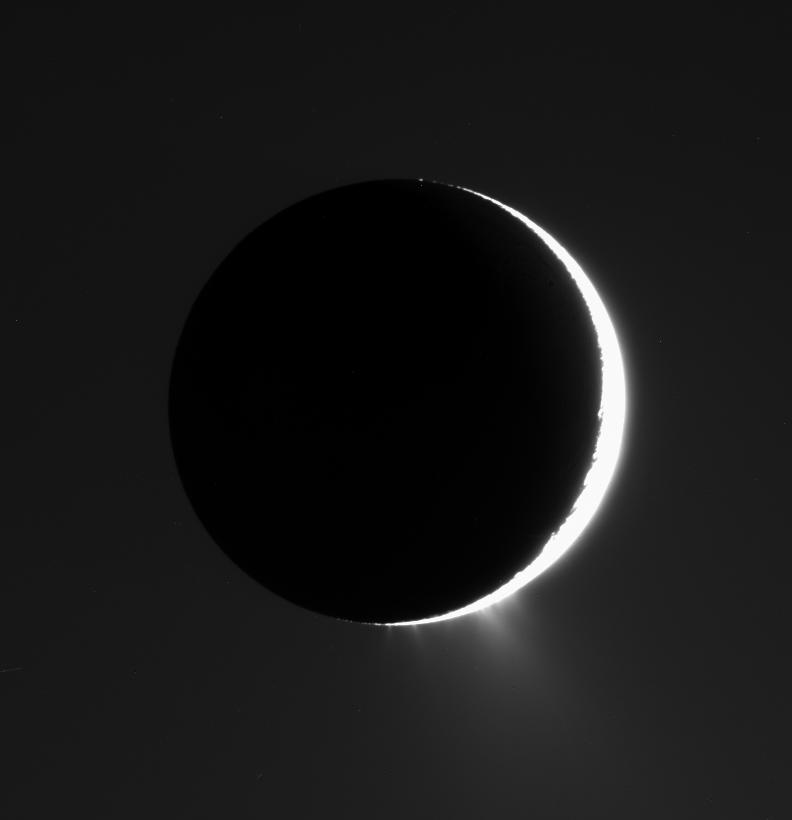
Great to see Dione on the manifest, also one of Saturn's most interesting & picturesque moons & may not be totally inert, with quite a wide range of surface features & a very interesting history.
The first really close pass of a co-orbital, Helene, Dione's leading Trojan. Helene, Dione's leading co-orbital moon. A small moon with dimensions of 36 KM x 32 KM x 30 KM. This will be the closest scientific pass of a minor Saturn moon since Phoebe in June 2004. Helene below. Irregularly shaped & cratered.
Rhea gets a second very close pass, hopefully shedding light as to why 1,528 KM wide Rhea remained so unevolved, despite it's fairly large size (probably fairly low density has something to do with it).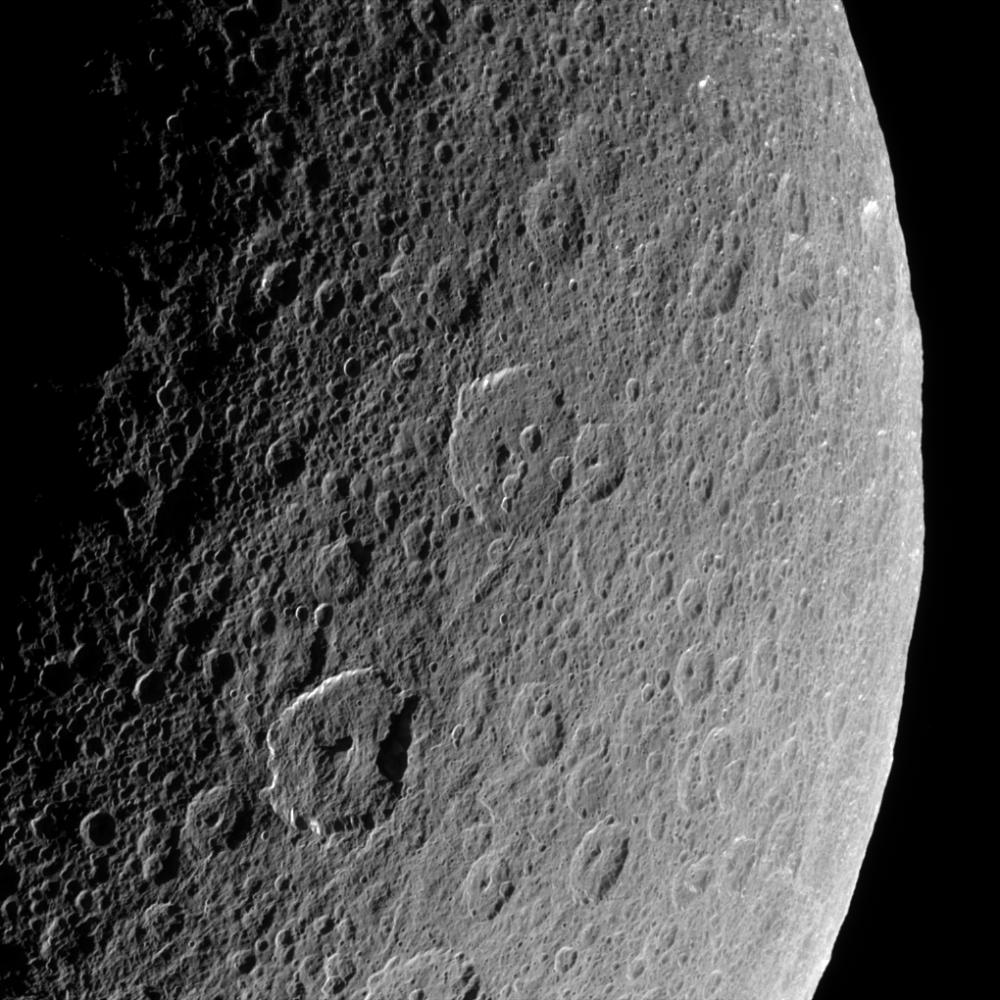
Shame Cassini cannot revisit Iapetus, but the extension is fascinating none the less.
We'll get to see Saturn itself change seasons, will be interesting to see if after December 2009, the southern polar region of Saturn starts turning blue, as the north polar region has been?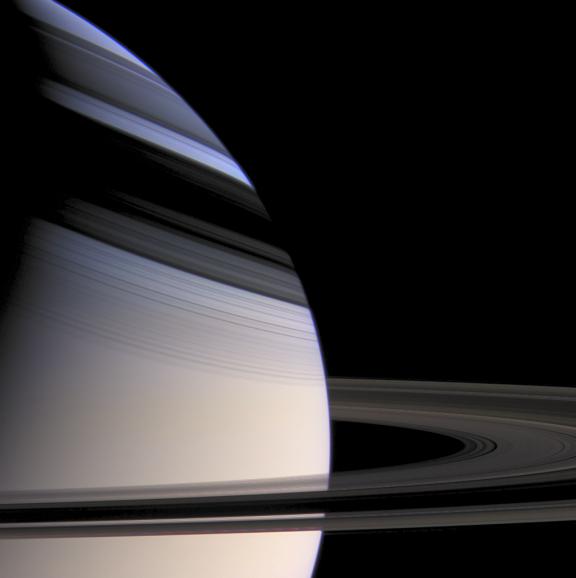
All in all, fantastic news.
Andrew Brown.
"I suddenly noticed an anomaly to the left of Io, just off the rim of that world. It was extremely large with respect to the overall size of Io". Linda Morabito on discovering that the Jupiter moon Io was volcanically active. Friday 9th March 1979.
Offline
Like button can go here
#270 2008-04-17 02:40:12
- cIclops
- Member
- Registered: 2005-06-16
- Posts: 3,230
Re: Cassini-Huygens - NASA/ESA Saturn orbiter & Titan lander
Very nice images!
The extended tour design process - video - 15 Apr 2008
Interview with Bob Mitchell, Cassini Project Manager - audio - 15 Apr 2008
[color=darkred]Let's go to Mars and far beyond - triple NASA's budget ![/color] [url=irc://freenode#space] #space channel !! [/url] [url=http://www.youtube.com/user/c1cl0ps] - videos !!![/url]
Offline
Like button can go here
#271 2008-05-14 05:30:06
- cIclops
- Member
- Registered: 2005-06-16
- Posts: 3,230
Re: Cassini-Huygens - NASA/ESA Saturn orbiter & Titan lander

Long-lived Storm - 29 Apr 2008
It is no Great Red Spot, but these two side-by-side views show the longest-lived electrical storm yet observed on Saturn by NASA's Cassini spacecraft.
The views were acquired more than three months after the storm was first detected from its lightning-produced radio discharges on Nov. 27, 2007. See PIA08410 for an earlier color view of this storm. Cassini imaging scientists believe the storm to be a vertically extended disturbance that penetrates from Saturn's lower to upper troposphere.
The view at left was created by combining images taken using red, green and blue spectral filters, and shows Saturn in colors that approximate what the human eye would see. The storm stands out with greater clarity in the sharpened, enhanced color view at right. This view combines images taken in infrared, green and violet light at 939, 567 and 420 nanometers respectively and represents an expansion of the wavelength region of the electromagnetic spectrum visible to human eyes. This view looks toward the un-illuminated side of the rings from about 3 degrees above the ringplane. Janus (181 kilometers, or 113 miles across) appears as a dark speck just beneath the rings in both images.
These images were obtained with the Cassini spacecraft wide-angle camera on March 4, 2008, at a distance of approximately 1.3 million kilometers (800,000 miles) from Saturn. Image scale is 74 kilometers (46 miles) per pixel.
[color=darkred]Let's go to Mars and far beyond - triple NASA's budget ![/color] [url=irc://freenode#space] #space channel !! [/url] [url=http://www.youtube.com/user/c1cl0ps] - videos !!![/url]
Offline
Like button can go here
#272 2014-07-02 13:32:53
- Excelsior
- Member
- From: Excelsior, USA
- Registered: 2014-02-22
- Posts: 120
Re: Cassini-Huygens - NASA/ESA Saturn orbiter & Titan lander
Starting in late 2016, the Cassini spacecraft will begin a daring set of orbits that is, in some ways, like a whole new mission. The spacecraft will repeatedly climb high above Saturn's north pole, flying just outside its narrow F ring. Cassini will probe the water-rich plume of the active geysers on the planet's intriguing moon Enceladus, and then will hop the rings and dive between the planet and innermost ring 22 times.
Because the spacecraft will be in close proximity to Saturn, the team had been calling this phase "the proximal orbits," but they felt the public could help decide on a more exciting moniker. In early April, the Cassini mission invited the public to vote on a list of alternative names provided by team members or to suggest ideas of their own.
Personally, I understand the biological contamination concerns, but I'd think they'd want to squeeze every bit of functionality out of it as possible, and wait until things start to wear out. If that is happening, they haven't indicated it. This seems a bit arbitrary, even budget motivated.
The Former Commodore
Offline
Like button can go here
#273 2014-07-03 12:07:14
#274 2014-07-03 16:46:28
- Excelsior
- Member
- From: Excelsior, USA
- Registered: 2014-02-22
- Posts: 120
Re: Cassini-Huygens - NASA/ESA Saturn orbiter & Titan lander
The point seems to be to shift it into a roughly polar orbit, and eventually into the atmosphere to prevent biological contamination of the system.
The Former Commodore
Offline
Like button can go here
#275 2017-09-16 20:14:58
- SpaceNut
- Administrator
- From: New Hampshire
- Registered: 2004-07-22
- Posts: 29,636
Re: Cassini-Huygens - NASA/ESA Saturn orbiter & Titan lander
NASA's Cassini Mission Ends After 13 Years
NASA confirmed communication with the Cassini spacecraft has been lost after completing a “death dive” into the upper atmosphere of Saturn.
Cassini was able to transmit new data about the planet's composition as long as its antenna remained pointed toward Earth, with the assist from small thrusters. Then, the spacecraft burned and disintegrated due to the heat and high pressure of the hostile atmosphere. It became part of the planet it set out to explore.
Offline
Like button can go here